40 standard labels for chemical containers
Container Labeling | Office of Environmental Health and Safety | ECU OSHA requires that labels on incoming containers of hazardous materials must not be removed or defaced until the container is empty and rinsed. No product or chemical shall be accepted without an adequate identifying label. Original containers should be labeled with the date received and the date opened. Rules for Proper Secondary Container Labeling - HSI Storage bottles for solutions or dilutions of a chemical. Sample vials or sealable tubes. Large batches of the same compound may be labeled collectively, provided that they are stored and handled as a group. Exceptions. Only a few exceptions apply to secondary container labels. These include: If the container size is impractical to house a label.
Container Labels Reading and work safely-Safety Poster - HSSE WORLD GHS Labels for Primary Containers, Primary chemical containers are the bags, barrels, bottles, boxes, cans, cylinders, and drums that you receive from the manufacturer. These containers should be labeled following the GHS mandates per the GHS label example above and include all six labeling elements.

Standard labels for chemical containers
› sites › defaultBRIEF - Occupational Safety and Health Administration Hazard Communication Standard: Labels and Pictograms standard also requires the use of a 16-section safety data sheet format, which provides detailed information regarding the chemical. There is a separate OSHA Brief on SDSs that provides information on the new SDS requirements. All hazardous chemicals shipped after June 1, Labeling of Secondary Containers | Occupational Safety and Health ... Section 1910.1200 (f) (6) (ii) requires that workplace labeling include "product identifier and words, pictures, symbols, or combination thereof, which provide at least general information regarding the hazards of the chemicals, and which, in conjunction with the other information immediately available to employees under the hazard communication... Chemical Hazardous Waste Containers: EPA and DOT Labeling Requirements "Labels" are always diamond-shape; and their size must adhere to international standards, measuring at least 4″ x 4″ (100 mm) on each side, square-on-point. Everything else (applicable to non-bulk packaging) is merely "marking.", The DOT uses nine categorical HazMat labels: Explosives, Compressed gas, Flammable and combustible liquid,
Standard labels for chemical containers. Proper Labeling Chemical Containers - Hazcom ... - OSHA Review OSHA requires every original chemical container to have a primary shipping label from the manufacturer with a few exceptions: Drugs for patient care, consumer chemicals, and pesticides, including disinfectants and dental unit waterline cleaners, are not subject to the labeling requirements. Alternatives to GHS Labeling for Workplace Chemical Containers - Lion ... 4. Resell the products without proper labels. Live on April 19: GHS Compliance for Hazmat Shippers Webinar. Challenges of These 4 GHS Shipping Options. The memo goes on to dissect the options for chemical distributors listed above. Option 4—shipping containers without GHS labels—is a clear violation of the OSHA's Hazard Communication ... Secondary Container Labels 101: HazCom and WHMIS - ERA Environmental In the U.S., the 2012 Hazard Communication Standard (HCS) is used and in Canada, the Hazardous Products Regulations (HPR) was established. ... Even better is to use a system that automates the entire SDS authoring and Secondary Container Label authoring - one chemical database, built-in templates, complete hazard determinations, and the full ... PDF HEALTH & SAFETY Chemical Container Labeling All containers that contain a "Hazardous Chemical" must be labeled for the health and safety of employees, students, visitors, and emergency responders. By OSHA definition, a "Hazardous Chemical" means any chemical which is classified as a physical or health hazard, a simple asphyxiant, combustible gas, pyrophoric gas, or hazard not otherwise c...
› ehs › filesStandard Operating Procedure Chemical Storage Guidelines Page ... 8.9.1 Store in airtight containers in a dark, cool, and dry place. 8.9.2 Label containers with receiving, opening, and disposal dates. 8.9.3 Periodically test for the presence of peroxides. 8.10 Toxic Chemicals 8.10.1 Store according to the nature of the chemical, using appropriate security where necessary. 9.0 CONTINGENCIES: Labeling small containers | Occupational Safety and Health Administration When containers are so small that it is infeasible to include all of the HCS 2012 label elements on the label, and when the use of pull-out labels, fold-back labels, tags, or other methods of labeling are not feasible, OSHA will allow a practical accommodation for labeling. › chemical › mychemMyChem | EHS - University of Washington They help the University comply with federal, state and local hazardous material regulations, including Hazardous Material Storage and Use Permits, Hazard Communication, Community Right-To-Know and the Chemical Facility Anti-Terrorism Standard. MyChem can also be used to: Generate a chemical waste collection request GHS Label Requirements, Guidelines, and Best Practices OSHA adopted GHS label requirements into their Hazardous Communication Standard (HCS) at the end of 2009. From there, it took years of work to revise regulations and implement GHS into OSHA's Hazardous Communication (HazCom) regulations. The first GHS standards were introduced in HazCom 2012, and were fully implemented by OSHA in 2016.
GHS Container Labels | EHS - Anschutz Medical Campus GHS Container Labels. OSHA has adopted the new hazardous chemical labeling requirements as part of the effort to harmonize with the United Nation's Globally Harmonized System (GHS) of Classification and Labeling of Chemicals. The new label provides information to workers on the specific hazardous chemical. The container limits the label size ... A Guide to OSHA's New GHS Chemical Labeling Requirements The GHS-inspired standards will require chemical manufacturers and importers to label chemical containers with 1) a harmonized signal word 2) GHS pictogram (s) 3) a hazard statement for each hazard class and category and 4) a precautionary statement. These elements are discussed in greater detail below: Chemical Container Labels | EHS Dev - University of Washington The label on an original chemical container must be legible and written in English. It must include the chemical/product name as shown on the SDS and the manufacturer's name and address. Do not accept materials if the label is illegible or missing required information. (See example of original label below). Download secondary chemical container labels | EHS If your laboratory uses secondary containers filled with chemicals, the secondary containers must comply with OSHA's Hazard Communication Standard for Labels and Pictograms. For your convenience, EH&S designed secondary chemical labels that can be downloaded from our website and printed onto Avery 5163 labels. You may choose from three designs:
PDF Chemical Labeling Guidelines - UGA 2.2 All secondary chemical containers can have a National Fire Protection Agency (NFPA) safety diamond affixed (see Attachment 1) 2.3 All secondary chemical containers must have a UGA‐URAR chemical label affixed (see Attachment 1), or other comparable labeling. ,
GHS Labeling Requirements: The Definitive Guide [2021 Update ... - Luminer What Does GHS Stand For? GHS stands for Globally Harmonized System of Classification and Labeling of Chemicals. It is an internationally-recognized standard for labeling containers that hold hazardous materials. Currently, more than 65 nations have adopted some version of these standards.
Color Coded Labels for Chemical Storage and Segregation Select the Search button next to the field in order to open the color code list and assign the codes. 2. Print color code labels. The Actions menu enables users to print color code labels for the active location or Container record. Select Actions > Labels > Storage/Shipping Labels Select the COLOR_CODES Label format and click on the OK button.
› msds › oshaOSHA Hazard Communication Standard, 29 CFR 1910.1200 at ILPI Chemical manufacturers, importers, distributors, or employers who become newly aware of any significant information regarding the hazards of a chemical shall revise the labels for the chemical within six months of becoming aware of the new information, and shall ensure that labels on containers of hazardous chemicals shipped after that time ...
4 Quick Tips to Help You Ace OSHA Secondary Container Labeling This means following the GHS standards for labeling primary hazardous chemical containers regardless of transference of contents or intended use. Tip #3: Choose Durable Secondary Container Labels to Ensure Legibility, You've consulted the SDS from the supplier. Your secondary container label contains all six required elements.
GHS Labels for Secondary Containers | HCL Labels, Inc. HCL Labels, Inc. offers a library of over 800 ready-made chemical GHS labels for secondary containers. GHS-labeled secondary containers are required by state and federal law to be labeled with a GHS Safety label, indicating which chemical is in use. HCL Labels offers GHS Labels in various sizes, formats, and multilingual options.
Requirements for Shipped Container and Workplace Labels NFPA 704 label REQUIREMENTS, NFPA 704 is a recognizable and easily understood labeling system that provides a general idea of a material's hazards. Some safety data sheets (SDSs) may provide the NFPA hazard ratings. If the hazard ratings are not provided, you can find the information in the following sections of the SDS: Download Infographic pdf,
› sites › defaultHazard Communication Standard Labels Standard (HCS). All labels are required to have pictograms, a signal word, hazard and precautionary statements, the product identifier, and supplier identification. A sample revised HCS label, identifying the required label elements, is shown on the right. Supplemental information can also be provided on the label as needed.
Chemical Container Labeling - Northwest Safety Here are some of the key requirements to be aware of: All labels must have pictograms, a signal word, hazard and precautionary statements, the product identifier, and supplier identification. Workplace labels must be provided in English. Other languages should be added to the label if applicable or necessary.
› chemical-container-labelsChemical Container Labels | EHS - University of Washington Chemical waste labels. Follow the How to Label Chemical Waste Containers instructions when disposing of hazardous chemical waste. All hazardous chemical waste mus t be labeled with the UW label shown unless the material is still in its original manufacturer’s container. Containers need to be labeled as soon as waste begins to be accumulated ...
ohs-workplacelabels | Environmental Health & Safety | Washington State ... Workplace Labels for Chemicals. Washington Administrative Code (WAC) 296-901, Hazard Communication Standard, states that all hazardous chemical containers in the workplace must be labeled.This includes secondary, or workplace, containers into which chemicals have been transferred from the shipped, or manufacturer's container (e.g. cleaners/disinfectants transferred to spray bottles).
› ldpe-chemical-compatibility-chartLDPE Chemical Compatibility Chart - calpaclab.com LDPE Chemical Compatibility Chart: Check the chemical compatibility of LDPE (low density polyethylene) with various chemicals, solvents, alcohols and other products. LDPE is defined by a density range of 0.910–0.940 g/cm3. It is not reactive at room temperatures, except by strong oxidizing agents, and some solvents cause swelling.
Information on hazardous chemical labels | Safe Work Australia A hazardous chemical is correctly labelled if it is packed in a container and has a label written in English. Pictograms and text on the label should be clear. The label must also be firmly fixed to the hazardous chemical's container. It should not be hidden or in a spot where it could be removed, such as on the lid. The label must include the:
Everything You Need to Know About Labeling Secondary Containers - LEM Workers expect original chemical containers to be marked with OSHA-compliant labeling but struggle to understand whether secondary containers should be labeled. Recently, the Hazard Communication Standard (HCS) aligned US chemical labeling standards with the international GHS regulations.
Secondary Container Label Requirements | HCL Labels These secondary containers are required to be labeled with a GHS chemical label, given if any of the following events occur: -The material is not used within the work shift of the individual who makes the transfer. -The worker who made the transfer leaves the work area. -The container is moved to another work area and is no longer in the ...
Container Labeling: A Key to Compliance - Occupational Health & Safety Containers also must have the following identification on the container, label or tag [29 CFR 1910.1200 (f) (1)]: The identity of the hazardous chemical. Appropriate hazard warnings. The name and ...
Chemical Hazardous Waste Containers: EPA and DOT Labeling Requirements "Labels" are always diamond-shape; and their size must adhere to international standards, measuring at least 4″ x 4″ (100 mm) on each side, square-on-point. Everything else (applicable to non-bulk packaging) is merely "marking.", The DOT uses nine categorical HazMat labels: Explosives, Compressed gas, Flammable and combustible liquid,
Labeling of Secondary Containers | Occupational Safety and Health ... Section 1910.1200 (f) (6) (ii) requires that workplace labeling include "product identifier and words, pictures, symbols, or combination thereof, which provide at least general information regarding the hazards of the chemicals, and which, in conjunction with the other information immediately available to employees under the hazard communication...
› sites › defaultBRIEF - Occupational Safety and Health Administration Hazard Communication Standard: Labels and Pictograms standard also requires the use of a 16-section safety data sheet format, which provides detailed information regarding the chemical. There is a separate OSHA Brief on SDSs that provides information on the new SDS requirements. All hazardous chemicals shipped after June 1,











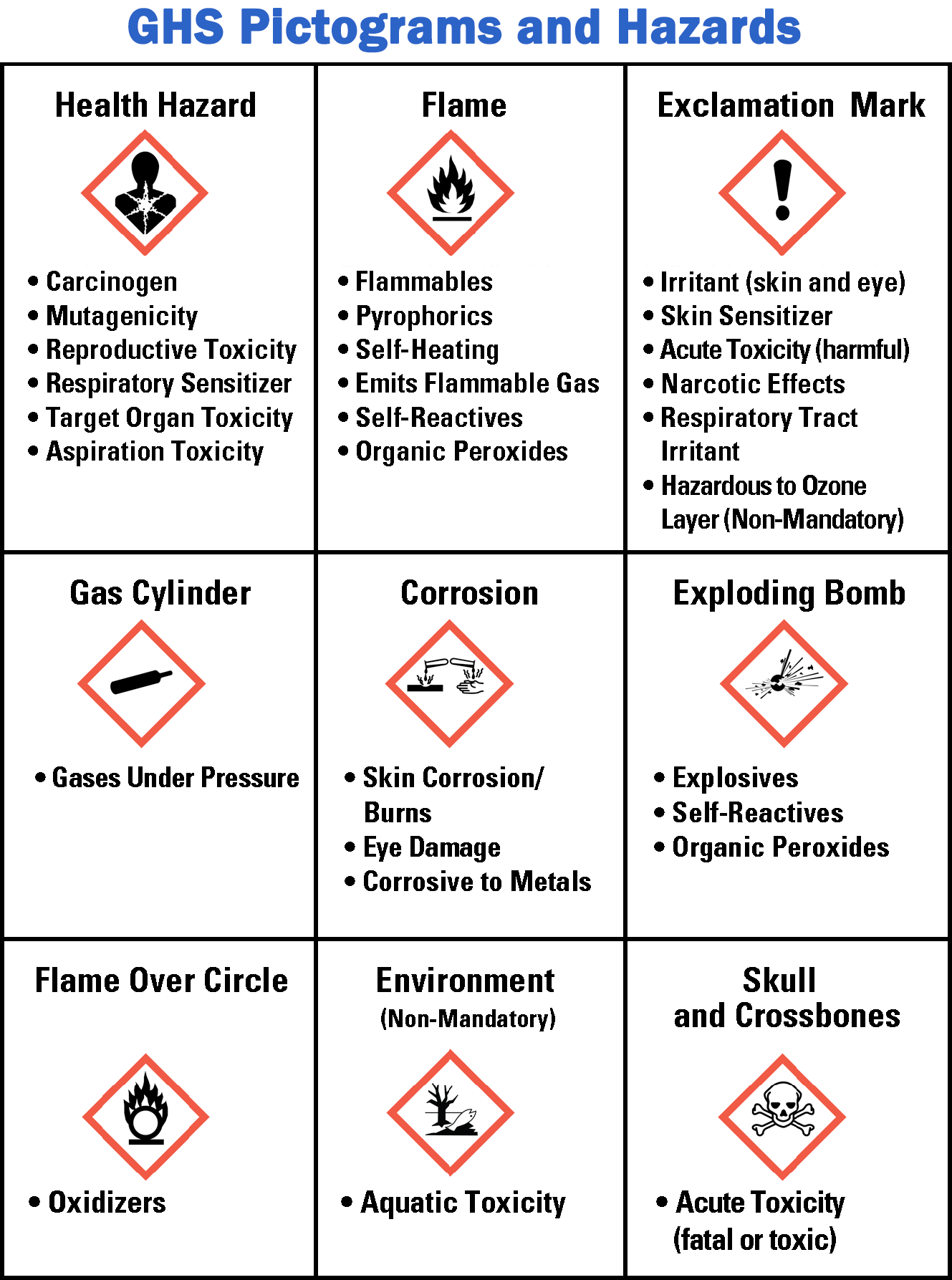






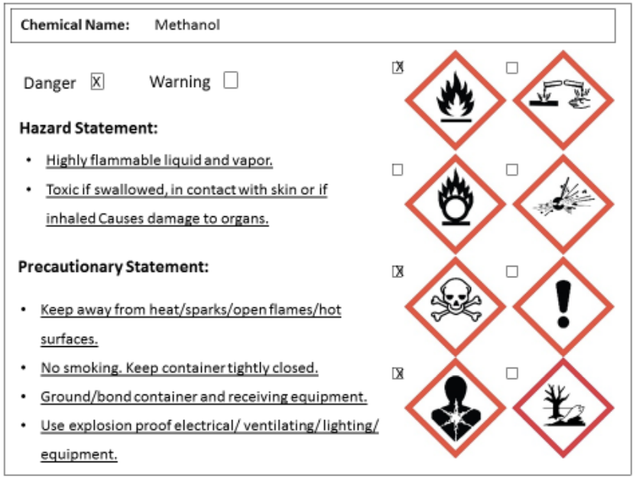
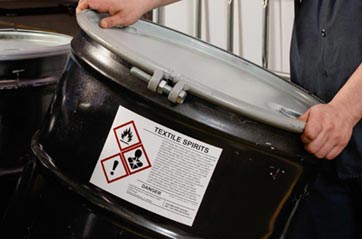


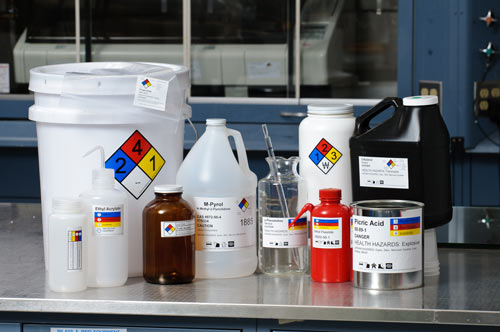

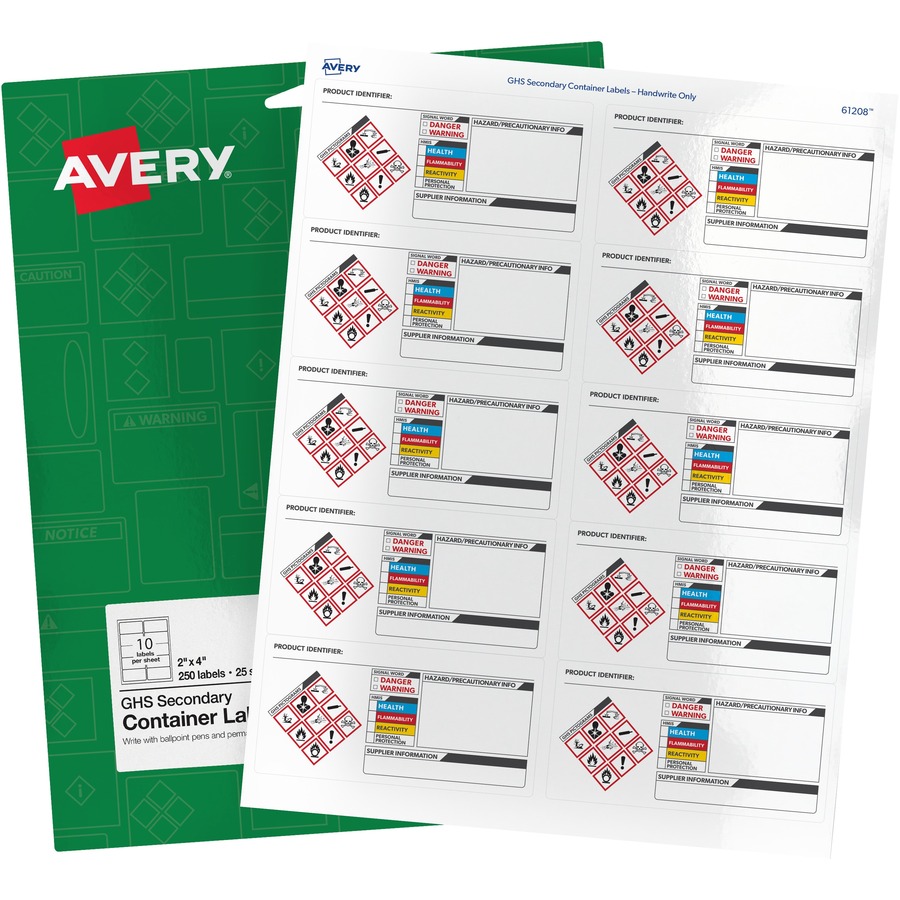



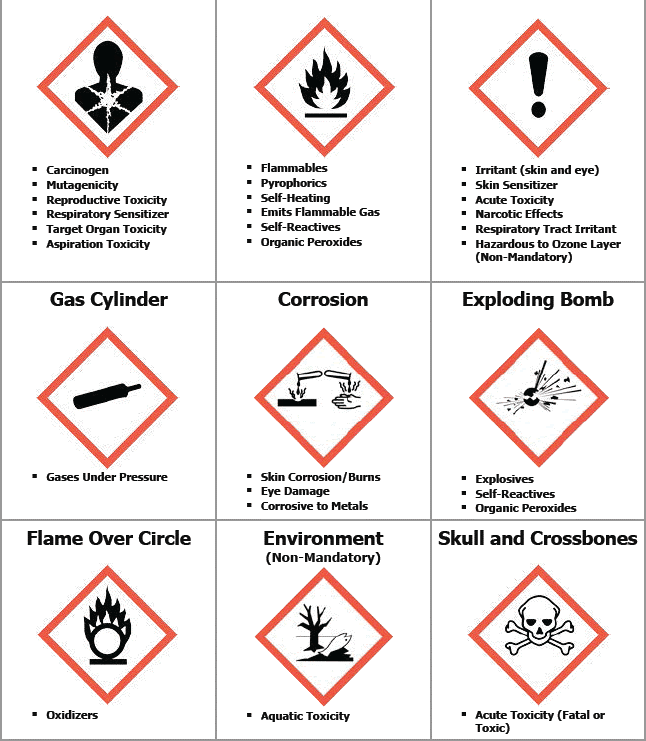

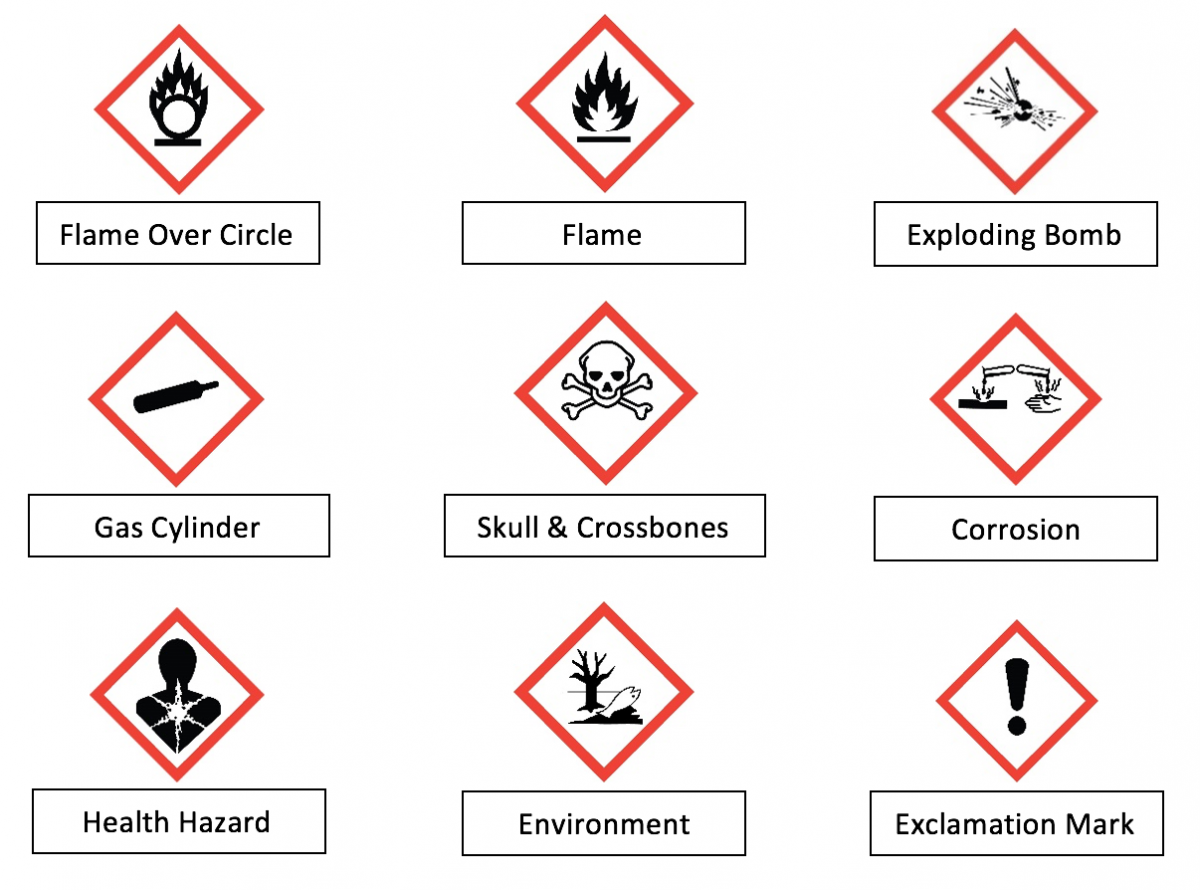


Post a Comment for "40 standard labels for chemical containers"